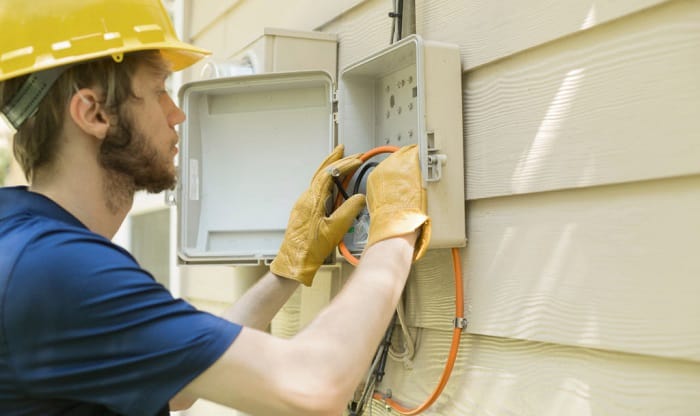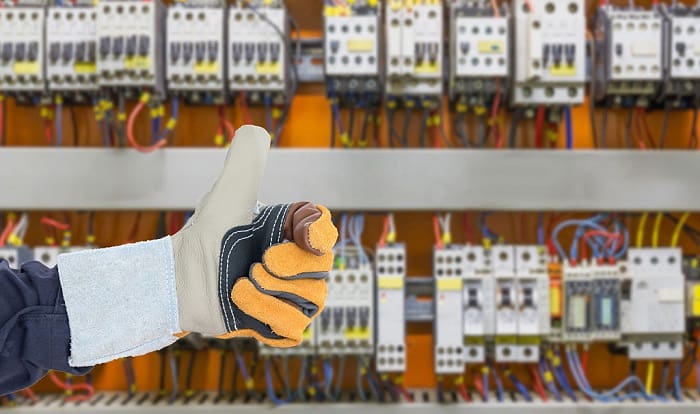Leather gloves, especially pairs made of genuine leather, are popular among workers. They can resist cuts, punctures, heat, and flame well, ensuring our hands are protected against specific hazards. But, these pairs have their limits, as they cannot resist chemicals well.
Also, many might wonder, ‘Do leather gloves protect from electric shock?’ In truth, when we wear our leather gloves and rubber gloves that have electricity insulation, we are safe when dealing with electricity.
Read on to find out the appropriate way to wear your hand protectors for a safe day at work.
Table of Contents
- Are Leather Gloves Safe for Electrical Work
- Do Leather Gloves Conduct Electricity
- What Affects How Much Leather Gloves Protect Against Electricity
- Are Leather Gloves Ideal for Electrical Sparks?
- How Much Voltage Can Leather Gloves Handle
- How to Use Leather Gloves Right to Shield Against Electricity
- Conclusion
Are Leather Gloves Safe for Electrical Work
Leather often acts as the additional layer that defends against punctures, cuts, and burns when we handle electrical work. But we still need rubber insulation in the glove to protect against electrical shocks. Therefore, electricians cannot wear leather gloves alone for handling hazardous tasks.
Do Leather Gloves Conduct Electricity
No, they do not. Please know that leather materials are not electricity-conductive, so they can act as an insulator. We can use leather gloves as one of the safety components for electrical work.
What Affects How Much Leather Gloves Protect Against Electricity
Rubber gloves with insulation
The combination of insulating rubber gloves and a leather protector result in good shielding for electricians. You can maximize their effectiveness by wearing a rubber pair first, then covering it with a leather pair. That way, you are safe from electrical shocks, cuts, and punctures by tools or exposure to hazardous chemicals.
Type of workplaces
- Domestic worksites – As you handle tasks around the house in a DIY project, the risk of an electric shock is small as long as you wear suitable gloves. This is because you do not have to deal with high-voltage wires of a complicated electrical system or huge engines.
- So, it is less necessary to wear a thick insulating rubber pair, as putting on a leather protector will do.
- Industrial workplaces – In these settings, live wires and high-voltage machines are present; thus, wearing rubber gloves is a must. But, we also should wear a leather pair to increase the protection capability.
Moisture content in the leather gloves
Dry leather gloves protect against electric shocks better than wet ones; that’s one thing we should keep in mind. Therefore, when handling tasks in humid setups, it’s critical to keep the leather protector dry at all times.
A good fit
This factor applies to nearly all kinds of work gloves we wear, including ones that resist chemicals, heat, abrasion, or electricity. Since a leather protector should be worn over a rubber pair, we should find one that offers a rather tight fit to our hands to block electricity better.
Are Leather Gloves Ideal for Electrical Sparks?
Yes, they are of decent use. According to the Occupational Safety and Health Administration (OSHA), leather gloves are effective personal protective equipment (PPE) against sparks.
Other than that, they shield our hands against moderate heat levels and rough objects. We can also rely on these pairs for hazards caused by blows and chips.
How Much Voltage Can Leather Gloves Handle
As stated above, a suitable leather glove can be a part of a gloving system that keeps workers safe from electrical shocks. According to OSHA, these leather protectors for utilities come with a class 2 rating. This means the gloves can handle up to 17 000V.
Here’s what you should know about electrician gloves’ class divisions. Selecting the right glove system depends on how many voltages you deal with at work:
- Class 00 – under 500 V maximum use (AC)
- Class 0 – 1000 V maximum use (AC)
- Class 1 – 7500 V maximum use (AC)
- Class 2 – 17000 V maximum use (AC)
- Class 3 – 26500 V maximum use (AC)
- Class 4 – 36000 V maximum use (AC)
How to Use Leather Gloves Right to Shield Against Electricity
- Test the gloves before use – The preparation should be done thoroughly as we wear the tight-fitting rubber gloves first, then put on the leather ones. Make sure to do a quick visual check to see if the gloves have any scratches or punctures.
- Keep gloves away from moisture – We all know how water and moisture can absorb into leather gloves, which are porous by nature. So, you can replace the pair when it’s soaked wet or dampened by sweat. Make sure to keep the leather gloves as dry as possible during your work with electrical machines and wires.
- Turn off the machine/engine power before work – Wearing PPE does not mean we can be careless when handling dangerous electrical machines. Therefore, use this rule of thumb: test if the circuit is already shut off, and double-checking is recommended.
- Measure the glove size to find a good fit – You must measure the dimension of your hands, including the circumference around the palm and the length from the tip of your middle finger to your wrist. These figures will help you find a pair that offers both protection and flexibility required for the job.
- Put on other insulating PPE – Work gloves alone are not enough. We should also wear shoes with PVC or plastic soles that prevent electric shock. Make sure to follow the mandatory regulations of your workplace to keep yourself safe always.
Conclusion
So, do leather gloves protect from electric shock? Yes, they can when worn with rubber gloves underneath. That is to say, leather gloves prevent electric shock when paired with an insulator.
Because the material is not the best in shielding against electricity, it is important to have other protection features when dealing with high-voltage machines and sharp tools.
Overall, electricians should be geared with a good gloving system that includes a pair of leather protectors.
If you find the article helpful, do not hesitate to leave comments or share it with others. Thank you for reading!

This is Edward Manning, the editor in chief of Construction Informer. Quite a bit of my time is spent researching the market and interviewing experts in the field so that I can give you reliable information.



